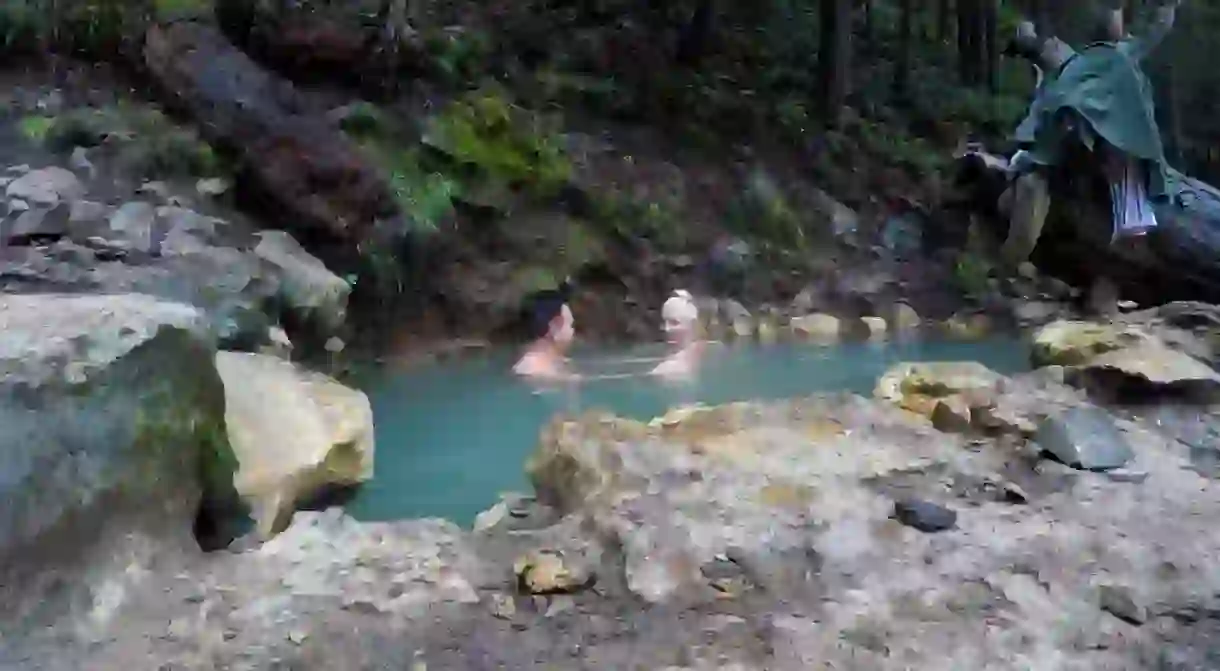Umpqua Hot Springs Is Hidden in an Oregon Forest

Few things feel better for aching muscles than that first dip in a hot spring, followed by the world’s biggest sigh as your tired body finds the perfect position. Here’s everything you need to know about Umpqua Hot Springs.
Who doesn’t crave a hot bath after hiking through the wilderness? The only problem, of course, is that you’ve got to get back home or to a hotel first. Not in the Pacific Northwest.
This land of looming peaks, verdant forests and hop-heavy IPAs, stretching from Oregon and Idaho in the south to British Columbia in the north, is highly geologically active. That means many places have hot springs, including the much-photographed Umpqua Hot Springs.

Visiting Umpqua Hot Springs
There’s a reason these springs get plenty of attention. Hidden among the trees in Umpqua National Forest, Oregon, this 2,640ft (805m)-high mountainside oasis perches on a cliff above a river, meaning you get immense views while bathing in hot water. You can lie flat, perch with your feet on the lip of the pool or shelter beneath an overhang as the steam gathers around you.
The water rises from deep in the earth, picking up mineral deposits that some experts believe can help with everything from dry skin to digestion, before trickling out of the pools and down to the river below, leaving rich red and orange deposits on the mossy rocks.
How to do it
The springs are around two-and-a-half hours’ drive from Bend and a little over five hours from Portland, both in Oregon. It’s less than a mile (1.6km)’s walk from the parking lot to the springs and back, but it’s fairly steep and the weather can be changeable, so hiking boots and raincoats are a good idea.
Once there, keep it pristine for everyone else – Umpqua Hot Springs has had problems with litter in the past, so carry yours out. There are no changing rooms, and springs are clothing optional, so be aware that while you might be packing your costume, you may be sharing the pools with some folks who aren’t.
The parking lot fee is US$5 per vehicle per day – or free if you have a Northwest Forest Pass.
Exploring Umpqua National Forest
This park covers almost a million acres of Southern Oregon, and elk, deer, eagles, black bears and cougars are found in its mixed forest. Among the highlights for visitors are Toketee Falls, a waterfall that tumbles over columns of basalt, and Steamboat Falls, which salmon fight their way up in summer and fall. Hiking, mountain biking, rock climbing, boating, skiing and snowshoeing are all popular activities.
Why are the hot springs here?
The Pacific Northwest may be a famously damp part of North America, but it’s a different story under the surface. The Ring of Fire, the line of volcanoes that circle the Pacific ocean, runs through here, and Mount Saint Helens, in Washington, erupted as recently as 1980, depositing ash in 11 different US states.
Major events like this are thankfully rare. But even when the volcanoes are quiet, giant chambers beneath the earth can heat water to over 300F (149C), and some of the resulting liquid rises to the surface through cracks to emerge from hot springs at around a bather-friendly 100F (38C). While underground, the water collects minerals such as silica and sulfate, which help give the springs their distinctive smell and may offer real health benefits.
Where else can I take a dip?
The US has some great hot springs. You can spot the Northern Lights from Chena Hot Springs in Alaska, ride a snowmobile to Idaho’s Burgdorf Hot Springs or kick back with mountain views in Riverbend Hot Springs, New Mexico.
Farther afield, Iceland, Japan and New Zealand are famous for their waters, and many countries have their own traditions, as well as pools that are sometimes as stunningly located as Umpqua Hot Springs.













